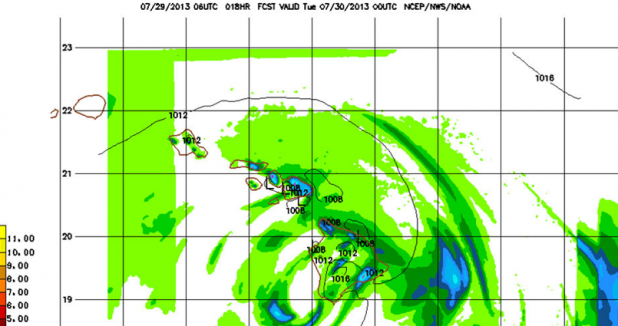 The National Weather Service uses that hardware for projects such as the Hurricane Weather Research and Forecasting (HWRF) model, seen here.[/caption] Just in time for hurricane season, the National Weather Service has finished upgrading the supercomputers it uses to track and model super-storms. “These improvements are just the beginning and build on our previous success. They lay the foundation for further computing enhancements and more accurate forecast models that are within reach,” National Weather Service director Louis W. Uccellini wrote in a statement. “These upgrades are a game-changer for the entire public and private weather industry. In addition to the benefits to our own forecasters and products, we will provide our private sector partners with better information to empower them to enhance their services.” The National Weather Service’s “Tide” supercomputer—along with its “Gyre” backup—are capable of operating at a combined 213 teraflops, which translates into 213 trillion calculations per second. The National Oceanic and Atmospheric Administration (NOAA), which runs the Service, has asked for funding that would increase that supercomputing power even more, to 1,950 teraflops. The National Weather Service uses that hardware for projects such as the Hurricane Weather Research and Forecasting (HWRF) model, a complex bit of forecasting that allows the organization to more accurately predict storms’ intensity and movement. The HWRF can leverage real-time data taken from Doppler radar installed in the NOAA’s P3 hurricane hunter aircraft. "These forecasting advances can save lives,” U.S. Senator Bill Nelson (D-FL), a NOAA advocate, wrote in a statement. “It's going to allow for better tracking of life-threatening storms and more accurately predict when and where they'll hit, and with what intensity." The U.S. Government actually utilizes a variety of supercomputers for all sorts of tasks. For example, researchers at the National Nuclear Security Administration (NNSA) rely on “Sequoia,” located at the Department of Energy’s Livermore National Laboratory, to conduct virtual nuclear weapons tests; other systems help researchers with everything from astrophysics to materials testing. But the newly upgraded “Tide” is one of the few supercomputers that could directly help save lives. Image: NOAA
The National Weather Service uses that hardware for projects such as the Hurricane Weather Research and Forecasting (HWRF) model, seen here.[/caption] Just in time for hurricane season, the National Weather Service has finished upgrading the supercomputers it uses to track and model super-storms. “These improvements are just the beginning and build on our previous success. They lay the foundation for further computing enhancements and more accurate forecast models that are within reach,” National Weather Service director Louis W. Uccellini wrote in a statement. “These upgrades are a game-changer for the entire public and private weather industry. In addition to the benefits to our own forecasters and products, we will provide our private sector partners with better information to empower them to enhance their services.” The National Weather Service’s “Tide” supercomputer—along with its “Gyre” backup—are capable of operating at a combined 213 teraflops, which translates into 213 trillion calculations per second. The National Oceanic and Atmospheric Administration (NOAA), which runs the Service, has asked for funding that would increase that supercomputing power even more, to 1,950 teraflops. The National Weather Service uses that hardware for projects such as the Hurricane Weather Research and Forecasting (HWRF) model, a complex bit of forecasting that allows the organization to more accurately predict storms’ intensity and movement. The HWRF can leverage real-time data taken from Doppler radar installed in the NOAA’s P3 hurricane hunter aircraft. "These forecasting advances can save lives,” U.S. Senator Bill Nelson (D-FL), a NOAA advocate, wrote in a statement. “It's going to allow for better tracking of life-threatening storms and more accurately predict when and where they'll hit, and with what intensity." The U.S. Government actually utilizes a variety of supercomputers for all sorts of tasks. For example, researchers at the National Nuclear Security Administration (NNSA) rely on “Sequoia,” located at the Department of Energy’s Livermore National Laboratory, to conduct virtual nuclear weapons tests; other systems help researchers with everything from astrophysics to materials testing. But the newly upgraded “Tide” is one of the few supercomputers that could directly help save lives. Image: NOAA National Weather Service Upgrades Storm-Tracking Supercomputers
[caption id="attachment_11294" align="aligncenter" width="618"]  The National Weather Service uses that hardware for projects such as the Hurricane Weather Research and Forecasting (HWRF) model, seen here.[/caption] Just in time for hurricane season, the National Weather Service has finished upgrading the supercomputers it uses to track and model super-storms. “These improvements are just the beginning and build on our previous success. They lay the foundation for further computing enhancements and more accurate forecast models that are within reach,” National Weather Service director Louis W. Uccellini wrote in a statement. “These upgrades are a game-changer for the entire public and private weather industry. In addition to the benefits to our own forecasters and products, we will provide our private sector partners with better information to empower them to enhance their services.” The National Weather Service’s “Tide” supercomputer—along with its “Gyre” backup—are capable of operating at a combined 213 teraflops, which translates into 213 trillion calculations per second. The National Oceanic and Atmospheric Administration (NOAA), which runs the Service, has asked for funding that would increase that supercomputing power even more, to 1,950 teraflops. The National Weather Service uses that hardware for projects such as the Hurricane Weather Research and Forecasting (HWRF) model, a complex bit of forecasting that allows the organization to more accurately predict storms’ intensity and movement. The HWRF can leverage real-time data taken from Doppler radar installed in the NOAA’s P3 hurricane hunter aircraft. "These forecasting advances can save lives,” U.S. Senator Bill Nelson (D-FL), a NOAA advocate, wrote in a statement. “It's going to allow for better tracking of life-threatening storms and more accurately predict when and where they'll hit, and with what intensity." The U.S. Government actually utilizes a variety of supercomputers for all sorts of tasks. For example, researchers at the National Nuclear Security Administration (NNSA) rely on “Sequoia,” located at the Department of Energy’s Livermore National Laboratory, to conduct virtual nuclear weapons tests; other systems help researchers with everything from astrophysics to materials testing. But the newly upgraded “Tide” is one of the few supercomputers that could directly help save lives. Image: NOAA
The National Weather Service uses that hardware for projects such as the Hurricane Weather Research and Forecasting (HWRF) model, seen here.[/caption] Just in time for hurricane season, the National Weather Service has finished upgrading the supercomputers it uses to track and model super-storms. “These improvements are just the beginning and build on our previous success. They lay the foundation for further computing enhancements and more accurate forecast models that are within reach,” National Weather Service director Louis W. Uccellini wrote in a statement. “These upgrades are a game-changer for the entire public and private weather industry. In addition to the benefits to our own forecasters and products, we will provide our private sector partners with better information to empower them to enhance their services.” The National Weather Service’s “Tide” supercomputer—along with its “Gyre” backup—are capable of operating at a combined 213 teraflops, which translates into 213 trillion calculations per second. The National Oceanic and Atmospheric Administration (NOAA), which runs the Service, has asked for funding that would increase that supercomputing power even more, to 1,950 teraflops. The National Weather Service uses that hardware for projects such as the Hurricane Weather Research and Forecasting (HWRF) model, a complex bit of forecasting that allows the organization to more accurately predict storms’ intensity and movement. The HWRF can leverage real-time data taken from Doppler radar installed in the NOAA’s P3 hurricane hunter aircraft. "These forecasting advances can save lives,” U.S. Senator Bill Nelson (D-FL), a NOAA advocate, wrote in a statement. “It's going to allow for better tracking of life-threatening storms and more accurately predict when and where they'll hit, and with what intensity." The U.S. Government actually utilizes a variety of supercomputers for all sorts of tasks. For example, researchers at the National Nuclear Security Administration (NNSA) rely on “Sequoia,” located at the Department of Energy’s Livermore National Laboratory, to conduct virtual nuclear weapons tests; other systems help researchers with everything from astrophysics to materials testing. But the newly upgraded “Tide” is one of the few supercomputers that could directly help save lives. Image: NOAA
 The National Weather Service uses that hardware for projects such as the Hurricane Weather Research and Forecasting (HWRF) model, seen here.[/caption] Just in time for hurricane season, the National Weather Service has finished upgrading the supercomputers it uses to track and model super-storms. “These improvements are just the beginning and build on our previous success. They lay the foundation for further computing enhancements and more accurate forecast models that are within reach,” National Weather Service director Louis W. Uccellini wrote in a statement. “These upgrades are a game-changer for the entire public and private weather industry. In addition to the benefits to our own forecasters and products, we will provide our private sector partners with better information to empower them to enhance their services.” The National Weather Service’s “Tide” supercomputer—along with its “Gyre” backup—are capable of operating at a combined 213 teraflops, which translates into 213 trillion calculations per second. The National Oceanic and Atmospheric Administration (NOAA), which runs the Service, has asked for funding that would increase that supercomputing power even more, to 1,950 teraflops. The National Weather Service uses that hardware for projects such as the Hurricane Weather Research and Forecasting (HWRF) model, a complex bit of forecasting that allows the organization to more accurately predict storms’ intensity and movement. The HWRF can leverage real-time data taken from Doppler radar installed in the NOAA’s P3 hurricane hunter aircraft. "These forecasting advances can save lives,” U.S. Senator Bill Nelson (D-FL), a NOAA advocate, wrote in a statement. “It's going to allow for better tracking of life-threatening storms and more accurately predict when and where they'll hit, and with what intensity." The U.S. Government actually utilizes a variety of supercomputers for all sorts of tasks. For example, researchers at the National Nuclear Security Administration (NNSA) rely on “Sequoia,” located at the Department of Energy’s Livermore National Laboratory, to conduct virtual nuclear weapons tests; other systems help researchers with everything from astrophysics to materials testing. But the newly upgraded “Tide” is one of the few supercomputers that could directly help save lives. Image: NOAA
The National Weather Service uses that hardware for projects such as the Hurricane Weather Research and Forecasting (HWRF) model, seen here.[/caption] Just in time for hurricane season, the National Weather Service has finished upgrading the supercomputers it uses to track and model super-storms. “These improvements are just the beginning and build on our previous success. They lay the foundation for further computing enhancements and more accurate forecast models that are within reach,” National Weather Service director Louis W. Uccellini wrote in a statement. “These upgrades are a game-changer for the entire public and private weather industry. In addition to the benefits to our own forecasters and products, we will provide our private sector partners with better information to empower them to enhance their services.” The National Weather Service’s “Tide” supercomputer—along with its “Gyre” backup—are capable of operating at a combined 213 teraflops, which translates into 213 trillion calculations per second. The National Oceanic and Atmospheric Administration (NOAA), which runs the Service, has asked for funding that would increase that supercomputing power even more, to 1,950 teraflops. The National Weather Service uses that hardware for projects such as the Hurricane Weather Research and Forecasting (HWRF) model, a complex bit of forecasting that allows the organization to more accurately predict storms’ intensity and movement. The HWRF can leverage real-time data taken from Doppler radar installed in the NOAA’s P3 hurricane hunter aircraft. "These forecasting advances can save lives,” U.S. Senator Bill Nelson (D-FL), a NOAA advocate, wrote in a statement. “It's going to allow for better tracking of life-threatening storms and more accurately predict when and where they'll hit, and with what intensity." The U.S. Government actually utilizes a variety of supercomputers for all sorts of tasks. For example, researchers at the National Nuclear Security Administration (NNSA) rely on “Sequoia,” located at the Department of Energy’s Livermore National Laboratory, to conduct virtual nuclear weapons tests; other systems help researchers with everything from astrophysics to materials testing. But the newly upgraded “Tide” is one of the few supercomputers that could directly help save lives. Image: NOAA 
